A Mountain Rescue from the Injured’s Perspective
Nighttime Rescue on Torrey’s Peak, October 14, 2020
by Mahir Dalwani
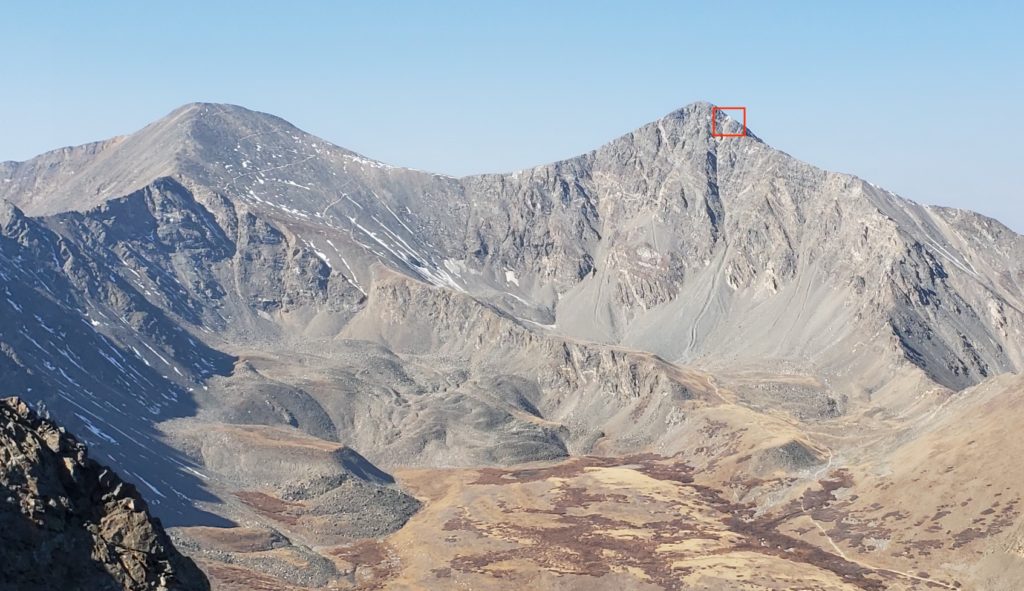
“Ok?” I asked.
“Ok,” he responded. “Don’t forget to move your toes.”
“Thanks. I think it’s around 8:16. What do you think?”
“I’d say so; 8:16 sounds right.”
And so, this engrossing conversation continued. It kept us alive. All we had to do was get to 8:30 so we could call Woody. Just 14 more minutes to survive and then we’d have an update from someone we’d never met before — and whom our lives greatly depended on.
About eight hours ago, my roommate Baba and I had just been starting our hike at Gray’s Peak’s trailhead in the Rockies. It was around 65°F with 10–12 mph winds, and the bright Colorado sun kept the clouds at bay. We would take this trail for an hour and then hop onto the adjacent Kelso’s Ridge — a riskier, more technical route — to summit Gray’s sister peak, Torrey’s. From there, we’d hike down the normal path after catching the sunset and be back in town just in time to gorge ourselves on brats at locally renowned Prost. It was all planned out.
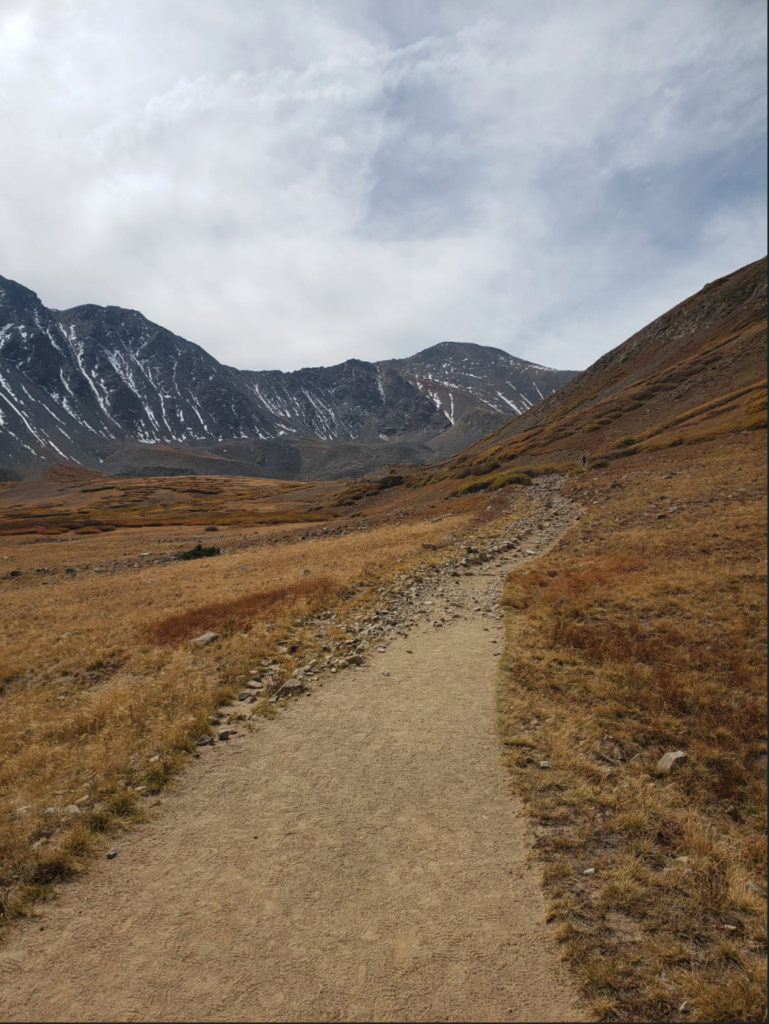
When we reached Kelso’s, we immediately felt that taking the route was a great decision. Just the two of us navigating the rocky expanse — it was a picture of teamwork. The only problem was, Kelso’s is a Class 3 scramble. While we were confident with challenging Class 2 routes, we didn’t realize what would be in store for us.
As we climbed on, the manageable Class 2 path gave way to steep and jagged cliffs. For five hours of ascent, we were confident — perhaps arrogant — solving one technical problem after another. Then we reached the penultimate step: a tower of white rocks that seemed adamant not to let us pass. It looked tough and neither of us could immediately see an obvious path to navigate the tower, but we had done our research so we were expecting it. Thoughts of hesitation were quashed with the knowledge that after this tricky bit of climb, a rewarding walk to the summit was waiting on the other side.
I took the lead with Baba close behind. Below us was about half a mile of steep, rocky terrain that eventually turned into a forest at the base. Both of us were on all fours, and after briefly looking down to see Baba only about five feet below me, I started studying the path to continue onward. While this last scramble wasn’t completely vertical, it was still a 60° incline. Snow painted the rocks, which made them hard to grasp, but the fading sunlight glinting off their surfaces made for a picture-perfect sunset. I took my gloves off for better gripping. Only 25 more feet to go.
I found a convenient rock to my right jutting out of the mountain face. Gingerly, I reached up and wiggled it to make sure it would support my body weight. Confident in its solidity, I placed my right hand on the rock and slowly started putting my body weight on it.
Just when I thought I was stable, the rock loosened and detached. The jerk was so powerful that it instantly dislocated my right shoulder. In sudden agony, I lost my balance. My vision blurred — I was in free fall.
Half a second later, I realized what was going on and started flailing my arms, hoping to grab onto anything. Just as quickly as the fall started, it ended. My hands caught hold of two rocks jutting out of the cliff.
Simultaneously, the hyperaware Baba slowed my fall by catching my hoodie while supporting himself with his opposite arm. I landed chest first and face down on a rock about five feet below.
Blood rushed to my head and I got my bearings. Luckily, I had landed softly, and the rock was big enough to hold my entire torso. Unluckily, it was on a slight downward slant and covered in snow. What’s more, my legs were dangling off. My right arm was immobile, and the pain was excruciating. I tried hoisting myself up, but with only three functioning limbs, I wasn’t going anywhere. I looked up and to my left to see Baba on another snow-covered platform an arm’s length from me.
“Call it in,” I said, but he already knew.
“Yeah, we need a chopper. I need your phone; mine might die soon.”
“You’ll have to grab my backpack; it’s in there.”
Baba cleared the snow off his platform, lay on his stomach, and reached down to help me get my backpack off. Manning both phones, Baba assessed battery life and signal strength. Through some sort of dumb luck, both had signal — at 14,000 feet altitude, on the side of a mountain. Baba dialed 911 and put it on speaker.
“911, what’s your emergency?”
“Help! We’re stranded on the side of a mountain — Kelso’s Ridge. My friend fell, and he’s lying on the side of a cliff. He’s injured and can’t move. We need a chopper, fast!”
“Sir, where are you?”
Baba found our coordinates on Google Maps and rattled them off.
“Sir, I’m going to phone the rescue team and call you back, all right?”
“NO!” Baba yelled. “Please don’t hang up.” What if the line disconnected? How would she call us back? What if the signal weakened and she couldn’t reach us?
“Sir, I will have an emergency rescue team contact you; don’t worry.” And she was gone.
Baba and I looked at each other. What now? We had to tell our parents. Baba called home and explained the situation to his mother. Next we called my parents, and all of a sudden, Baba was performing a juggling act of familial phoning.
It was about 45 minutes since the fall, and I started to realize I couldn’t stay in my position for much longer. Although I was stabilizing myself by wrapping my arms around a couple of smaller rocks jutting out of the mountain face, I was on a decline and slipping. In alarm, I yelled out to Baba and he hung up the phone — probably better anyway to keep it available for the rescue team and emergency services to call back.
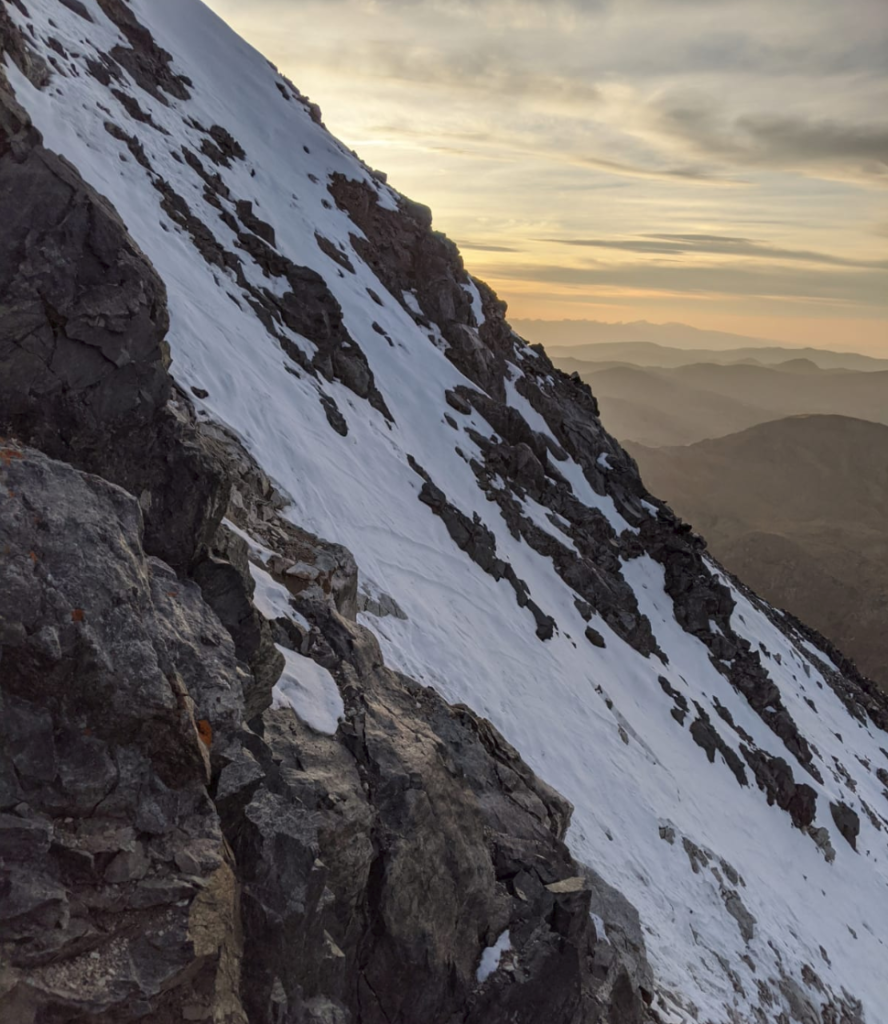
Baba decided the best course of action was to flip me and get me to a sitting position since I couldn’t climb up. With his support, I would have to swing my legs up onto my base rock in order to pivot and sit. He braced himself on his platform and extended his arm out to me. This was it — I had to let go of the support rock I was clinging on to.
Baba sensed the hesitation. “I’m secure,” he said. “I ain’t goin’ anywhere.”
With my good arm, I let go of my support rock and grabbed onto Baba’s arm. I knew each attempt would tax Baba’s strength, so in one fell swoop, I swung my legs and managed to get them up. I let go of Baba, pivoted 180°, planted my butt down on the rock and firmly gripped onto two rocks on each side of me. Baba had supported me for only a short time, but in hindsight it was a lifesaving ten seconds. Finally, I had my back to the mountain.
In the preceding hour or so, my only view had been a bunch of gray and black rocks and dirty snow. But now I could see the vastness of the land. Mountains extended to the horizon and faded into blobs of purple in the distance. The last photons from the setting sun’s rays were dancing to a song that only the gusty wind knew how to play. Below, a curved snowy mountain face teased us — it looked so manageable to maneuver — how’d we get stuck here? Above, stars began greeting us as if they were excited to have a couple of humans to accompany them through the night.
While I was taking it all in, the phone rang. Baba answered.
“Baba? I’m calling from the Alpine Rescue Team. My name is Woody.”
Woody, we later found out, was a mission coordinator for the Alpine Rescue Team. His tone was relaxed yet authoritative, as if this were a nightly exercise for him.
“Where are you, Baba?”
Baba again recited the coordinates.
Woody wasn’t interested. “Coordinates are fine but describe what you see. I’ve done that route over 50 times, so tell me everything you see.”
We both started blurting things out. The sun set on our left, so we were on the north face. Trees at the base of the mountain. Snow covering the rocks.
Woody cut us off. “Ok, I know exactly where you are. If you climb about 20 to 30 feet, you’re in safety and nearly at the peak. Try to climb up.”
“There’s no way,” I interjected. “I can’t move my right arm. My shoulder’s dislocated.”
Baba suggested, “Why don’t we go down? There’s snow cover so we could just butt slide down.” A good idea, I thought; after all, it wasn’t a vertical drop, so sliding slowly could be fine.
There was a slight pause from Woody. “Listen to me carefully. If you go down that mountain, you are going to die. There are cliffs you cannot see from your position. Either you go up, or you stay exactly where you are.”
Woody sounded like a general giving orders to his subordinates. It was clear, we were staying there.
“Here’s the reality,” he continued. “I’m getting a team together, but no one is reaching you for the next five hours. It’s too dark and windy for any helicopters, so you will have to wait for a ground team.”
My heart sank. The temperature was dropping, wind was picking up, and I didn’t think I had the energy to hold myself secure from slipping with only one functional arm for five hours.
Woody had one last piece of advice for us. “Call me every hour and turn your phones off to save battery.”
With that, the line went dead, and it was just Baba and me at 14,000 feet.
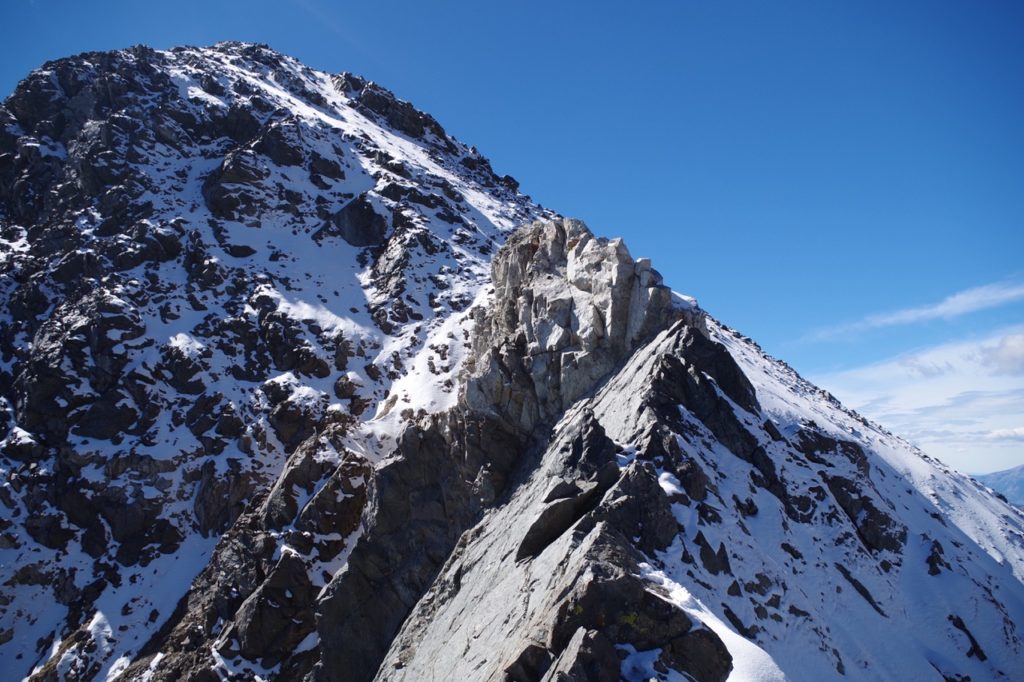
Baba checked the time on our phones and turned them off. It was 7:36, and the sky was nearly all black, but the half-moon still provided us with light to see. Baba and I memorized Woody’s phone number and decided that we would call him at 8:30, but since we didn’t have watches, we would just guess the time every couple of minutes. We agreed to say something every ten seconds even if it was just “ok,” and promised to be brutally honest about our mental and physical conditions. To prevent our extremities from freezing, we constantly reminded ourselves to wiggle our toes and fingers. These short conversations would keep us talking and our minds alert – no room for emotion, only focus on survival. We also convinced ourselves that we would be stuck until the morning. That way, even if the ground team found us and couldn’t rescue us, we would be prepared to hang on longer.
Around 8:00, the first cramps started kicking in due to heavy shivering from a sudden drop in temperature. First it was my left quad, and about 15 minutes later, both quads were cramping. My butt was numb from sitting on the snow for so long, so I gently tried lifting myself up with my arms to get some blood flow. I tried to control my breathing to keep my body temperature from falling too low and calm the shivering. When we thought it was 8:16, the Big Dipper appeared to our left. I trained my eyes on it and the neighboring stars, trying to determine other constellations.
At 8:25, we decided to call Woody. Baba turned on one phone to realize it was actually 8:35. Mentally, it was a big win for us to know we had survived longer than we thought – even if it was only ten minutes. Woody answered on the first try, and this time it felt like we were talking to a long-lost friend.
“How’re y’all doin’?” he asked.
“We’re all right.”
“I got some good news. The rescue teams have reached the base and should be up in two to three hours. Now tell me, do you guys see a road from where you’re sitting?”
Baba and I craned our necks. I saw a thin patch of road exposed from the jumble of trees and reported back to Woody.
“Perfect,” he said, “That’s I-70. I’m going to send a car to that patch right now and have the driver blink his lights. Let me know if you can see it.”
Sure enough, within a minute or so, a car appeared with blinking lights. It was again a big mental win for us. Woody knew exactly where we were and he had not only a rescue team hiking up for us but also emergency services vehicles at the base. Rejuvenated from the conversation, we hung up and decided to call back at 9:30.
The next hour went by similarly to the first, but it was getting tougher. I was starting to fade, so constant communication with Baba was crucial, but the cramps were getting worse and spread to my pecs and triceps. On top of that, hunger and dehydration pains kicked in, but I dared not move because even the slightest motion could mean a slip and a fall. Finally, we phoned Woody and he informed us that the rescue teams were an hour away. No special instructions from him on this call, but he did tell us that he was in touch with our families and had instructed them to not contact us to keep the phones free.
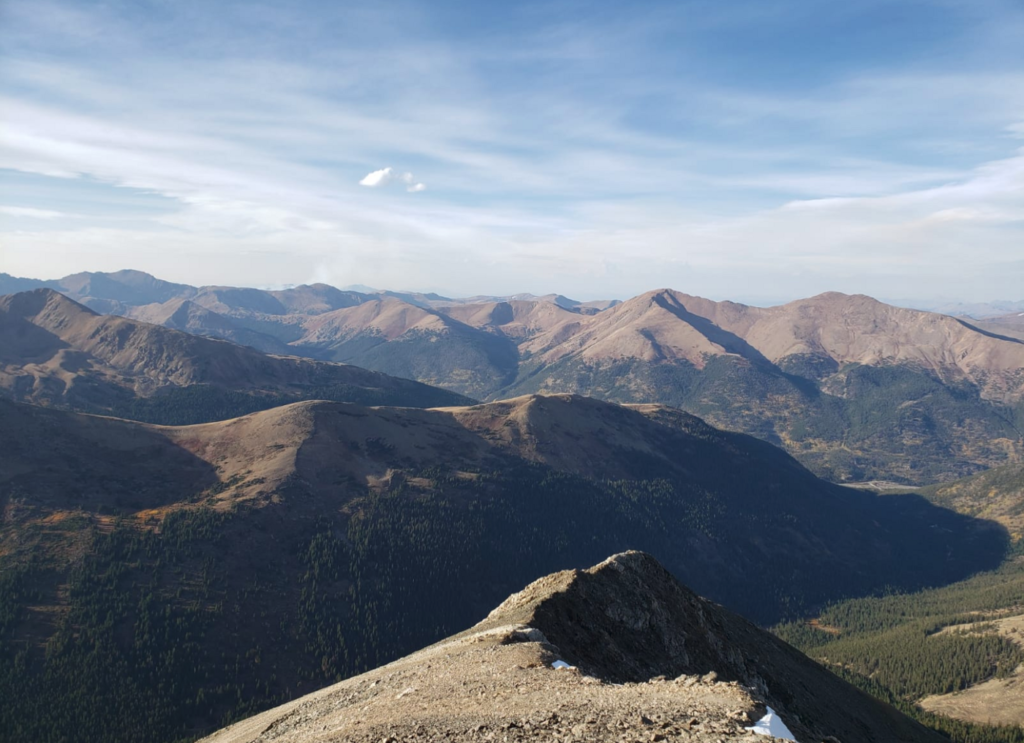
We sharpened our minds and dug deep. One more hour. Our conversations became more and more ludicrous: “Once upon a time, there was a tree … how was your day today ….” We just had to keep ourselves talking. By this time, the Big Dipper had taken some pity and conveniently repositioned itself directly in front of us, but the wind didn’t show the same mercy. Just 20 more minutes.
At 10:30, we called Woody again. “15 to 20 minutes, guys. They have headlamps on, so look out for lights. When they get you to the top, they’ll have food, water, medical supplies, and warm clothes.”
We thanked Woody and hung up. This was the home stretch. We started yelling out so the rescue team could find us. Ten minutes went by but no one was responding to our cries for help. A couple more minutes, we figured, and they’ll be here.
“HELLOOO!” we cried in unison and strained our ears for a response.
The wind cooperated just for a couple minutes, and suddenly, a faint “Hellloo …” greeted us. My heart started racing. “HELLLOOO! Can you hear us? We’re down here!”
“WE HEAR YOU! We’ll be right there!”
Baba looked up to his 7 o’clock, saw their headlamp lights, and guided them to our position. Within a couple minutes, they were standing 25 feet above us at the spot where Woody had told us to climb to. We yelled through the wind and explained the situation: I would not be able to climb unsupported due to the injury. I heard one of them speak into his radio, perhaps to Woody, “We have visual of the hikers, one is injured, preparing to descend now,” and then to us, “I’m going to the injured guy first.”
I figured the rescuer would need time to get down to where I was stranded – after all, it was dark, windy, and the path down was steep and snowy. But to my amazement, no more than 60 seconds later, he was standing right in front of me. He had chosen a rock that was only two feet wide and just a few inches away from me as his base. With his thick hiking boots, he cleared the snow off the rock, dug his soles in, and took his backpack off. He moved so fast; it was as if gravity didn’t apply to him. Then he turned around to face me, his headlamp shining on my face.
“Hey! I’m Curt. Nice to meet you.”
I was stunned. It was nearly the middle of a Friday night, and he was risking his life to save a complete stranger in a less than ideal environment. Despite that, he had the charm of a schoolboy during recess.
“Hey,” I responded, “I’m so glad to see you.”
“So, the good news is the guy up there – his name is Dale, by the way. Well, he has over 40 years of experience doing this stuff, so you’re in great hands. Bad news is, as for me, you’re my first rescue ever.”
I’m pretty sure I just stared blankly back at him, because after a pause, he continued, “Ha! Just messin’. I’ve been doing this for years.”
“Ok, so now to business. I’m going to put my harness on you and Dale is going to belay you up. The only sucky thing is you’re going to have to do the climb yourself, but I’ll be here to support you.”
Then he looked up to Dale and yelled, “How’re we doing up there?”
Dale said he had found a good spot to secure the rope but needed to clear the area of snow and loose rocks, which meant kicking the debris down our direction. Curt was like a chess grandmaster thinking steps ahead. Even before Dale finished his sentence, he’d already pulled out a spare helmet from his bag for me and leaned over me to act as a shield from the falling rocks and snow. This guy was a real-life superhero.
Dale worked to secure the rope while Curt helped put the harness on me. Once the two were ready, Dale threw the rope down and Curt tied it on my harness with a strong double figure eight knot. They took in the extra slack on the rope, and when they were confident everything was set, Curt yelled up to Dale, “On belay!”
“Belay on!” came the affirmative response, and we were off. First, Curt helped me up from my seated position. Blood went rushing to my butt, but my legs were cramped so they took a while to loosen up. I turned around to face the mountain – one last climb. I grabbed onto the rope and looked at Curt.
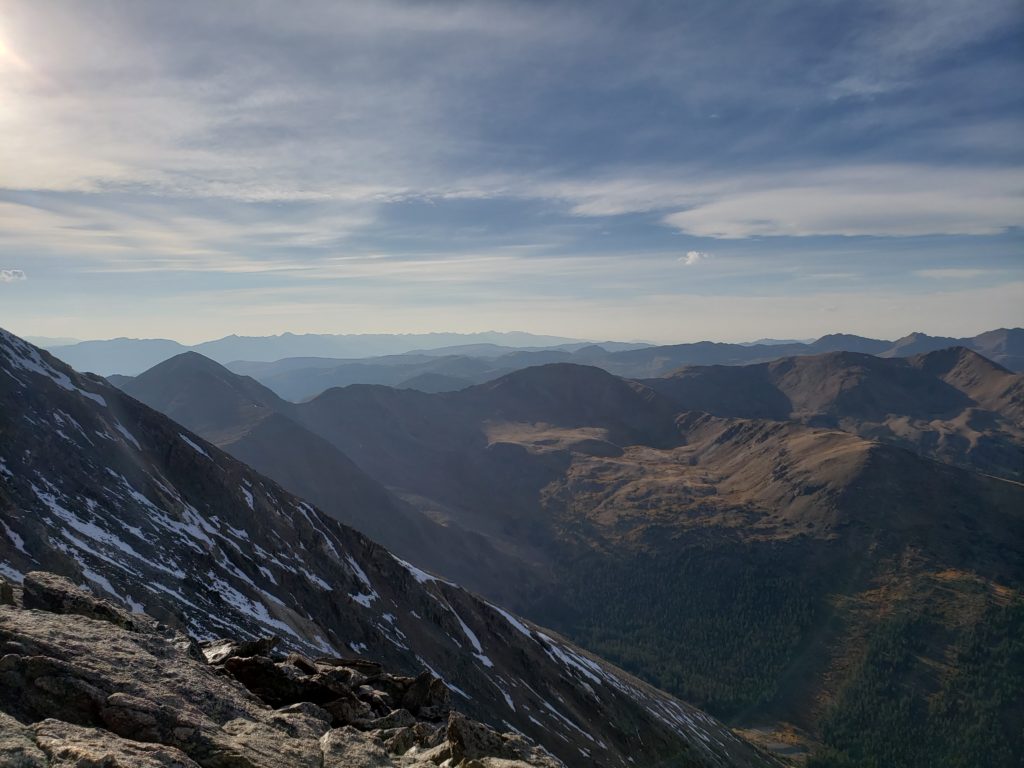
“You can hold onto that; it’s not going anywhere.” He already knew what I was going to ask and had the answer ready.
I grabbed the rope with my good arm and started climbing. Strength hadn’t returned to my legs yet; I immediately slipped and slammed into the mountain, but the rope kept me from falling farther. I shook my legs off and continued. Curt pointed to a foothold, and then the next. Each step up sent jolts of pain radiating through my body, as my shoulder was still dangling loose from its socket. Curt right behind me was climbing freehand. He gave me a helpful nudge when needed and lifted my morale with constant words of encouragement: “You’re doing great … don’t worry, Dale’s got you … almost there.”
I looked up. Dale was getting closer and closer. I stopped myself from thinking ahead about safety – there was still more to go. The only way I had made it to this moment was ridding myself of emotion to preserve energy for as long as possible. One last ounce of mental strength, I thought, just find the next footing.
With Curt on my heels, after one final push, I made it. I found myself standing next to a beaming Dale.
“Hey! Well done! I’m Dale.”
“Hi Dale, thank you so much. I’m Mahir.”
No sooner had Curt finished his climb up with me than he went down again to rescue Baba. Meanwhile, Dale loosened the rope from my harness to get it ready for its second mission. I couldn’t believe it. Two hours ago, I was nearly certain that we’d have to wait until the morning or that I would lose consciousness. Now that I no longer needed to fight for survival, fatigue, hunger, and dehydration took over my body all at once. Dale noticed me slumping and reassured me that the rest of the team would be there in just a few minutes with the supplies.
Thirty minutes later, Baba was rescued and standing beside me, totally exhausted. We were given glucose gummies, granola bars, and water with electrolytes. Four teammates arrived at the scene and gave us winter coats and pants for us to wear over our clothes. One pulled out a large plastic tarp from his backpack to shield us from the wind while we ate and regained strength. Curt and Dale slipped into the background to pack up the belay equipment. Phase I of the operation was complete.
But we still had to get back down the mountain. Once Curt and Dale finished packing up, the team reconvened to discuss the best path forward. They decided that we would finish the climb to Torrey’s Peak and then on the other side of the mountain rejoin the normal trail to walk down. Dale estimated we’d be down by 6 in the morning, but at this point, I had no idea what the time was.
The team gathered their belongings and we were off: a steep, quarter-mile hike to the summit. Curt and other rescuers helped hold my injured arm up as my shoulder was still out of its socket. Baba and I both had members of the team surrounding us at all times to keep us from falling and to give us the occasional nudge.
At the summit, there was another small group waiting for us. In addition to food and water, they were equipped with a couple 2-liter oxygen cylinders. The wind was howling so they quickly moved to get the tubing and tanks on us, and we continued. Finally, after about 13 hours from when Baba and I started at the trailhead, we were on our way down.
More and more members of the team kept on appearing. It was clear that they were stationed at key points on the trail. Two members had litters, small stretchers used in search and rescue missions. After about an hour of climbing down, the wind calmed and the food, water, and oxygen started helping. Since there were always three men with me and a three-hour hike down, we all got to talking.
Wes was a 66-year-old retired investment banker. There was so much to unpack there. First, he had just summited a 14,000-foot mountain, in darkness, with equipment, to help someone less than half his age all the way down. Second, he was an investment banker! Weren’t bankers supposed to retire in their Manhattan penthouses and ride off in their German cars?
When I asked Wes, he simply responded, “I love it up here, so I volunteer with the Alpine Rescue Team.” His answer floored me – I hadn’t realized that the team that rescued us were volunteers. I was expecting to get slapped with a bill the size of the American healthcare system itself, but no – they operate on a completely volunteer, no-charge basis.
I asked other members of the team about their backgrounds, and their responses continued to surprise me. Many members were, like Baba and me, in their mid-twenties and working in sales, engineering, and consulting fields by day. The difference was that by night, they turned into superheroes from the comics: the real Guardians of the Rockies.
When we reached the base, my heart swelled with gratitude. But how do you thank someone who not only just saved your life but also risked their own in doing so? I started thanking members of the team individually, but it didn’t feel enough. Words couldn’t express what I was feeling; frankly, I don’t think it had sunk in yet.
In a year marred by a global pandemic and sociopolitical unrest, I had forgotten that humans are capable of such good – without expecting or even wanting anything in return. Baba told me the next day that in a way he was sort of glad this happened, just so we could meet these beautiful people. Our gratitude went beyond the relief of our rescue. It was about learning about the Alpine Rescue Team and understanding what they stand for. It was about feeling a bond with strangers again, something the isolation of quarantine had robbed most of us of. Perhaps next time, as Dale had suggested during our hike down, instead of hanging off a cliff, we’d all simply meet for a beer.
Dale counted his men off, and the team helped us get the oxygen and borrowed equipment off. One by one they started dispersing. There was no fanfare, no cheers, but there was a sense of duty and camaraderie in the air. Curt and Dale waited around a bit to help us and asked if we needed medical services. They had an ambulance on call, ready and waiting. We assured them that we were going straight to the ER, so there was no need.
Finally, I asked Dale how we could ever thank them.
He looked at us. “Pay it forward.” With those parting words of wisdom, he got in his truck, and drove off.
The Alpine Rescue Team saved our lives that night. We were their 111th mission of the year, and in the following week, they completed four more. They’ve been in operation since 1959 and have conducted more than 130 local search and rescue missions per year since 2015. Basic math would suggest that just in the last half decade, they’ve saved well over 500 lives and probably around 10,000 in their 60+ years of existence. They pride themselves on their unique ability to respond at any time of day, completely free of charge. From firsthand experience, I believe the Alpine Rescue Team is one of the world’s most – if not the most – tactical, trained, and knowledgeable nonprofits.
They are truly veterans of nature.
A special thank you to Kathy for helping me polish and present my thoughts.
(All photos courtesy of Mahir Dalwani unless otherwise noted)

